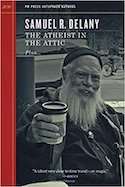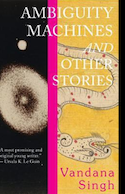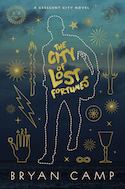Future Alternative Past: drugs
Every month, Nisi Shawl presents us with news and updates from her perch overlooking the world of science-fiction, fantasy, and horror. You can also look through the archives of the column.
Purple Haze
Drugs are good. Well, maybe not all drugs. But as a whole, as a group, they’re meant to help. And usually they do.
In SFFH, better living through chemistry is brought about most famously by the “spice” melange, a drug absolutely essential to navigators steering around interstellar trading ships. Frank Herbert’s influential 1965 novel Dune focuses on the fortunes of those who own the planet Arrakis (melange’s sole source), but there are also memorable portrayals of the blue-eyed, spice-addicted members of the interstellar Pilots Guild and the secretive “Bene Gesserit” cult, and Arrakeen natives.
Of relevant recent science fiction titles the best is Autonomous by Annalee Newitz. Her heroine, Jack, fabricates bargain-priced pharmaceuticals that buyers around the world dose themselves with for effects ranging from hangover-less partying to long, productive workdays.
Perhaps it’s authors’ need for conflict that causes us to concentrate on drugs’ negative effects. Even melange, in its creator’s mind so beneficial, so widely accepted, is also imagined as addictive. The “herbal” preparations imbibed by sword-and-sorcery’s favorite freak, Michael Moorcock’s cursed hero Elric of Melnibone, are also de facto addictive: without them he would die.
From good drugs that do bad things it’s a short step to plain old pure evil. The soma of Aldous Huxley’s Brave New World is the archetypal chemical oppression-enabler. Rendering the masses calm and mildly euphoric, self-administered soma greatly aids the maintenance of the novel’s global dystopia. There are scores of compounds with similar functions in later SFFH, such as the protein shakes consumed by slaughterhouse workers in Vandana Singh’s “Are You Sannata 3159?” (appearing in a collection reviewed below).
Often SFFH merely slaps a weird new name on an already existing drug. This is known in the trade as "calling a rabbit a smeerp,” and it’s annoying as fuck. Cute substitutes for the word coffee such as “klah,” “gvi,” or “caf,” don’t prove that readers have been transported to another realm. They prove that they’re in thrall to a short-cutting writer. Far more interesting are the stories casting aside well-worn tropes, as John Crowley does in Engine Summer, when his protagonist tokes up daily on pipes full of St. Bea’s Bread which is...not a drug.
Sometimes fantastical pharmaceuticals advance the plot, but don’t diverge much from the drugs we know; in her near-future novel Slow River, for example, Nicola Griffith’s heroine Lore may as well be ingesting heroine or meth or cocaine as the nameless drug that gets her through weeks of sex work. Sometimes they’re a collage of the traits of more familiar substances, like athelas or kingsfoil, the healing herb Aragorn uses in J.R.R. Tolkien’s The Fellowship of the Ring (partaking of several characteristics of mints and basil). Sometimes, in some skiffy stories, future drugs are identical with currently available ones, but they’re produced differently — manufactured in a vacuum or a zero-g environment, or grown in moss or duckweed, or in genetically-engineered milk animals. Which is where SFFH leaves off and reality takes over. Because these methods are being used right now.
Recent books recently read

Samuel R. Delany is one of the baddest of literary badasses. In 1962, at the ripe age of 20, he published his first novel, The Jewels of Aptor, and went on to win a slew of Hugos, Nebulas, and other major awards. Now he’s 76, and the latest entry in his decades-long career is The Atheist in the Attic, a collection from PM Press’s “Outspoken Authors” series. The title story posits secret encounters between Leibniz and Spinoza in historical Amsterdam — nothing sfnal here, but the novella’s Delanyesque explorations of meaning, mood, intention, and imagination are as delectable as any in his genre fiction, and as rich in the cognitive estrangement SFFH readers prize. It’s followed by “Racism and Science Fiction,” the influential 1998 essay which led to the founding of the Carl Brandon Society and which, sadly, proved all too accurate in its prediction of racist reactions to a growing nonwhite presence in the field. A brief interview conducted by Terry Bisson concludes this slim but essential book.

Another collection, Vandana Singh’s Ambiguity Machines and Other Stories (Small Beer) showcases a bit of what we’re fighting for. It’s a xenophile’s treasury of nonstandard plots, unfamiliar and finely crafted characters, and new ways to embrace the wonders of the universe, with particular attention paid to their scientific bases (Singh is a physics professor). My personal favorites are “Cry of the Kharchal,” a short story about birdwatching, time-traveling ghosts, and blocked poets; and a novella original to this publication, “Requiem.” Though the latter’s premise — a young woman seeks answers in the mysterious death of her aunt — provokes boredom by its mere mention, the actual story falls into none of the time-worn trope-traps you’d expect and delivered me, by its end, into a harsh but hopeful landscape.

Bryan Camp’s debut, The City of Lost Fortunes, (Houghton Mifflin Harcourt) was written in the back of a car escaping the ravages of Hurricane Katrina. It’s a novel haunted by New Orleans’ near-death experience. Filled with supernatural extensions of the cultural diversity the city’s famed for, Lost Fortunes introduces readers to Jude Dubuisson, a racially ambiguous demigod who’s tired of his divine powers. Dubuisson gets drawn into a rigged card game everyone tells him he can’t win, but since they expect him to play fair they’re in for a surprise. Camp clearly cares for the Crescent City’s soul, and he brings its scenes to sweltering life: the cafés, cemeteries, flood-damaged ruins, low-life bars, botanicas, pelican-skimmed causeways, diners, guard dogs, festivals — a phantasmagoric panorama of a true urban fantasy.
Couple of upcoming cons
Once again I recommend attending WisCon. It’s a favorite both of mine and my mom’s: chock full of decadence, wit, and glitter-laden feminazgûls. There’s a transgressive rave, childcare, a quiet room for sufferers of sensory overload, and a bake sale. This year’s Guests of Honor, the indomitable Tananarive Due and the intrepid Saladin Ahmed, will give their rousing keynote speeches over a feast of meringues, brownies, mousses, and other sweets. Come. Partake. If you can’t save the world with chocolate chip cookies, it’s not worth saving.
Or perhaps you’d rather not make a trek to the Midwest during the humid warmth of May (WisCon’s held in Madison, Wisconsin). If so, try BayCon, just down the coast, ten minutes from Frisco. This year the theme is Patchwork Fandom: Stitching the Generations Together (appropriate, given recent kerfuffles over congoing fandom’s alleged ageism). Guests of Honor include our local Girl Genius, Margaret Organ-Kean, artist and Magic the Gathering card illustrator extraordinaire.